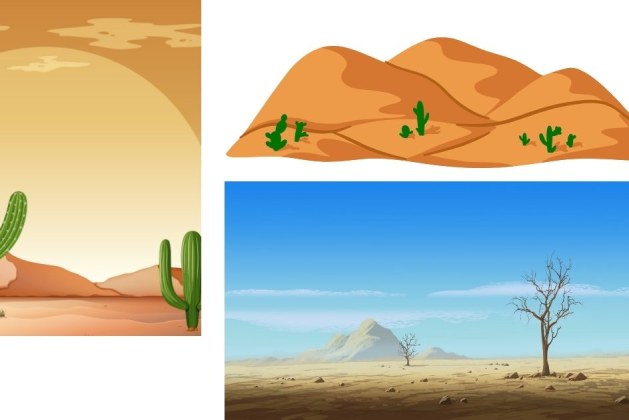Deserts are harsh environments characterized by extreme temperatures, minimal rainfall, and challenging living conditions for plants and animals. Despite these challenges, deserts are home to a variety of resilient plants that have adapted to survive in such a dry, arid climate. Desert plants have developed unique features and strategies to conserve water, protect themselves from the sun, and reproduce in the difficult conditions of the desert.
Adaptations of Desert Plants
Before diving into specific plant species, it’s important to understand the common adaptations that help desert plants thrive:
- Water Conservation: Many desert plants have developed ways to store water in their tissues, such as in the form of thick, fleshy stems or leaves.
- Deep Root Systems: Desert plants often have deep root systems that can reach underground water sources, allowing them to access moisture that is unavailable to plants with shallow roots.
- Reduced Leaf Surface Area: To minimize water loss through evaporation, many desert plants have small or no leaves at all. Some have spines instead of leaves to further reduce water loss.
- Protective Coverings: Many desert plants are covered in waxy coatings, thorns, or hairs that protect them from the intense heat and help retain moisture.
- Drought Dormancy: Some desert plants can survive long periods without water by entering a dormant state, only to “wake up” when rainfall occurs.
Common Desert Plants
While there are many plants that thrive in deserts, some of the most iconic and well-known species include:
1. Cacti
- Common Examples: Saguaro (Carnegiea gigantea), Prickly Pear (Opuntia), Barrel Cactus (Ferocactus)
- Adaptations: Cacti are perhaps the most famous desert plants. They have thick, fleshy stems that store water and are protected by spines. Cacti also have shallow but wide-spreading root systems that help them absorb rain quickly when it does occur.
- Role in Ecosystem: Cacti provide critical shelter and food for desert animals, such as birds and small mammals, which rely on the plant’s moisture-filled stems.
2. Joshua Trees (Yucca brevifolia)
- Adaptations: Joshua trees are well-adapted to desert life, with long, narrow leaves that conserve water. They also have deep taproots that allow them to reach underground water sources.
- Role in Ecosystem: Joshua trees are iconic plants in the Mojave Desert and provide a home for a variety of wildlife, including birds, lizards, and insects.
3. Creosote Bush (Larrea tridentata)
- Adaptations: This bush is well-known for its ability to survive long periods of drought. Its leaves are coated with a resinous substance that reduces water loss. The creosote bush also has a deep root system.
- Role in Ecosystem: Creosote bushes are crucial for the desert ecosystem, providing shelter and food for animals and serving as a stabilizer for desert soils.
4. Mesquite Trees (Prosopis spp.)
- Adaptations: Mesquite trees have long, deep roots that can reach groundwater even in the driest conditions. They also have small, feathery leaves that reduce transpiration and protect against the sun.
- Role in Ecosystem: Mesquite trees are important sources of food for desert animals, and their roots help prevent soil erosion in desert regions.
5. Agave
- Common Examples: Agave americana (Century Plant), Agave tequilana
- Adaptations: Agave plants store water in their thick, fleshy leaves and have a rosette growth pattern. Some species flower only once in their lifetime before dying, but in doing so, they produce large quantities of seeds.
- Role in Ecosystem: Agave plants are a food source for desert herbivores, and some species are crucial for producing products like tequila (from Agave tequilana).
6. Tumbleweed (Salsola tragus)
- Adaptations: Tumbleweeds are unique because they break off from their roots when they mature, allowing them to be carried by the wind. This helps them disperse their seeds over a wide area.
- Role in Ecosystem: Tumbleweeds can provide shelter and habitat for desert animals, but they are also seen as invasive species in some areas, as they can spread rapidly and displace other vegetation.
7. Brittle Bush (Encelia farinosa)
- Adaptations: The brittle bush has silvery, resin-coated leaves that reflect sunlight, helping to reduce water loss. It also has a shallow but widespread root system to capture water quickly.
- Role in Ecosystem: It is an important source of nectar for pollinators such as bees and is also a source of food for herbivores like rabbits and rodents.
8. Palm Trees (Phoenix dactylifera)
- Common Examples: Date Palm, Canary Island Date Palm
- Adaptations: Palm trees are often found in desert oases, where water is available. They have deep roots that can reach water sources far underground.
- Role in Ecosystem: Palm trees provide shelter for animals, and their fruits (like dates) serve as an important food source for humans and wildlife alike.
9. Bajada Grass (Pleuraphis rigida)
- Adaptations: This grass is well-suited to desert life with its ability to store water in its roots and its resistance to extreme heat and drought.
- Role in Ecosystem: Bajada grass helps stabilize desert soils and is an important food source for grazing animals like antelope.
Other Notable Desert Plants
- Saltbush (Atriplex spp.): A shrub with salt-tolerant leaves that can survive in saline desert soils.
- Prickly Pear (Opuntia spp.): Known for its edible pads and bright flowers, this plant is common in deserts and serves as food for wildlife.
- Desert Lily (Hesperocallis undulata): A beautiful flowering plant that blooms after rainfall, adapted to extreme temperatures.
Conclusion
Desert plants are highly specialized and resilient, evolving unique adaptations that allow them to thrive in the harsh, water-scarce environment. From the iconic cactus to the hardy Joshua tree, these plants not only survive but also play vital roles in maintaining the desert ecosystem. By storing water, providing food and shelter for animals, and stabilizing the soil, desert plants contribute to the biodiversity and sustainability of desert landscapes. Despite their ability to withstand extreme conditions, many desert plants face threats from climate change and human activity, making their conservation important for maintaining desert ecosystems for future generations.




Leave a comment